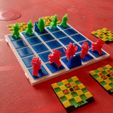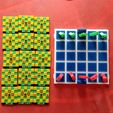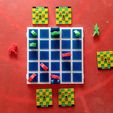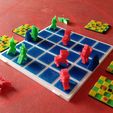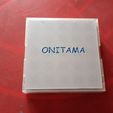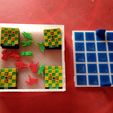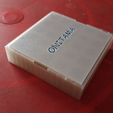Onitama is a dynamic CV on a 5x5 board, where each piece moves identically, but in a constantly changing way.
Descripción
In Onitama, each player has 4 pawns and 1 king (called the master). Each player has two cards dictating how the pieces may move, and a fifth card is put to the side, chosen from a deck of 16 different cards. Every turn, the player uses a card to move one piece (pawn or master) according to the card, and swaps their card with the extra card. The card they just used will enter their opponent's hand at the end of the opponent's turn. This means that players must consider not only how pieces move right now, but also how they will be able move a few turns later (Even if a certain series of moves and captures happens, different cards could have been used to accomplish it!)
Onitama is won either by capturing the opponent's master (called way of the stone), or navigating their master to the other team's temple, where the master starts (way of the stream). This encourages moving the master into the action, but players must also be careful not to let the master get trapped in a bad spot - especially since the movement patterns change quickly, so a seemingly safe position reveals itself to be dangerous if not carefully considered.
Setup
Each player starts with the pawns in a line, with the master in the center. The master's starting spot is called the temple. Movement cards are randomly selected from the set of 16 possible cards, two for each player, plus a fifth card set aside.
(https://www.chessvariants.com/play/pbm/drawdiagram.php?code=ppkpp%2F5%2F5%2F5%2FPPKPP&cols=5&set=alfaerie1&bcolor=332222)
Pieces
Pawns and master move in the same way - of course, don't let your master get captured! The 16 different movement cards are as follows (These decide how the pieces move) - note that some cards are flipped versions of another. These are listed together, with the first version being whichever one is more left-oriented, but are on seperate cards. Note also that the Boar is a rotation of the Horse/Ox, and the Crane, Mantis, Eel, and Cobra make a symmetry group as well, although these groups are listed seperately.
Las cartas estan hechas para que les cambies el color en el siguiente orden:
Negro
Verde
Amarillo
Rojo
Negro
Rules
From the deck of 16 cards, each player takes two movement cards, and a fifth is set aside at the start of the game. On their turn, each player must choose a card, and move a piece (either a pawn or a master) according to what the card allows. The player will then remove this card from their hand, and swap it with the card set aside. The card just played is now set aside and will enter the other player's hand at the end of their turn. If a player cannot move any piece, then the player swaps one of their cards, and play passes to the other player. If a card can be used, then the player cannot skip their turn, and must move a piece. Pieces may not land on other pieces of the same team, but can capture the other team's pieces. The Master starts in the middle of each player's first rank, called the Temple. If a Master is captured, then the capturing player wins the game. If a Master reaches the Temple on the other side of the board, then that player wins the game. Note that the rules do not prevent players from moving into check, so a player can win by moving their Master into the other team's temple, even if that square is guarded.
Notes
Onitama makes for a quick, dynamic variant. If you ever want to play with a friend, it won't take very long to play, but you also have to carefully consider the moves. The card system means that a safe structure might no longer support itself, and a piece which previously was safe is suddenly in danger, even without any pieces moving. All of this is accomplished with perfect information and no random chance beyond the initial setup, which makes it a good way to introduce chess and chesslike games to people with no experience.

/https://fbi.cults3d.com/uploaders/13795705/illustration-file/1590b7cb-6c50-4e7e-8cba-bd2b1124deac/WhatsApp-Image-2024-03-02-at-10.59.08-AM-1.jpeg)
